What does a princess cut diamond look like?
A princess cut diamond is a popular diamond shape that is typically square or rectangular in appearance. It is known for its modern and elegant look. Here are some key characteristics of a princess diamond cut:
Shape: Princess cut diamonds have a square or rectangular outline when viewed from the top. The corners are usually sharp, giving the diamond a distinct angular appearance.
Facets: Princess cut diamonds feature numerous facets that contribute to their brilliance and sparkle. Typically, they have a total of 58 or 76 facets, depending on the cutting style.
Brilliant-cut: Princess cut diamonds are considered brilliant-cut, meaning they are designed to maximize the reflection and refraction of light. This results in exceptional sparkle and brilliance.
Step-Cut Pavilions: Unlike round brilliant diamonds, princess cut diamonds have a step-cut pavilion. This means the lower portion of the diamond is comprised of parallel facets that create a staircase-like appearance when viewed from the side.
Square vs. Rectangular: Princess cut diamonds can come in both square and rectangular variations. Square princess cuts have a length-to-width ratio close to 1, while rectangular princess cuts have a greater length-to-width ratio.
Versatility: Princess cut diamonds are versatile and can be set in various types of jewelry, including engagement rings, pendants, earrings, and bracelets.
A rough princess diamond
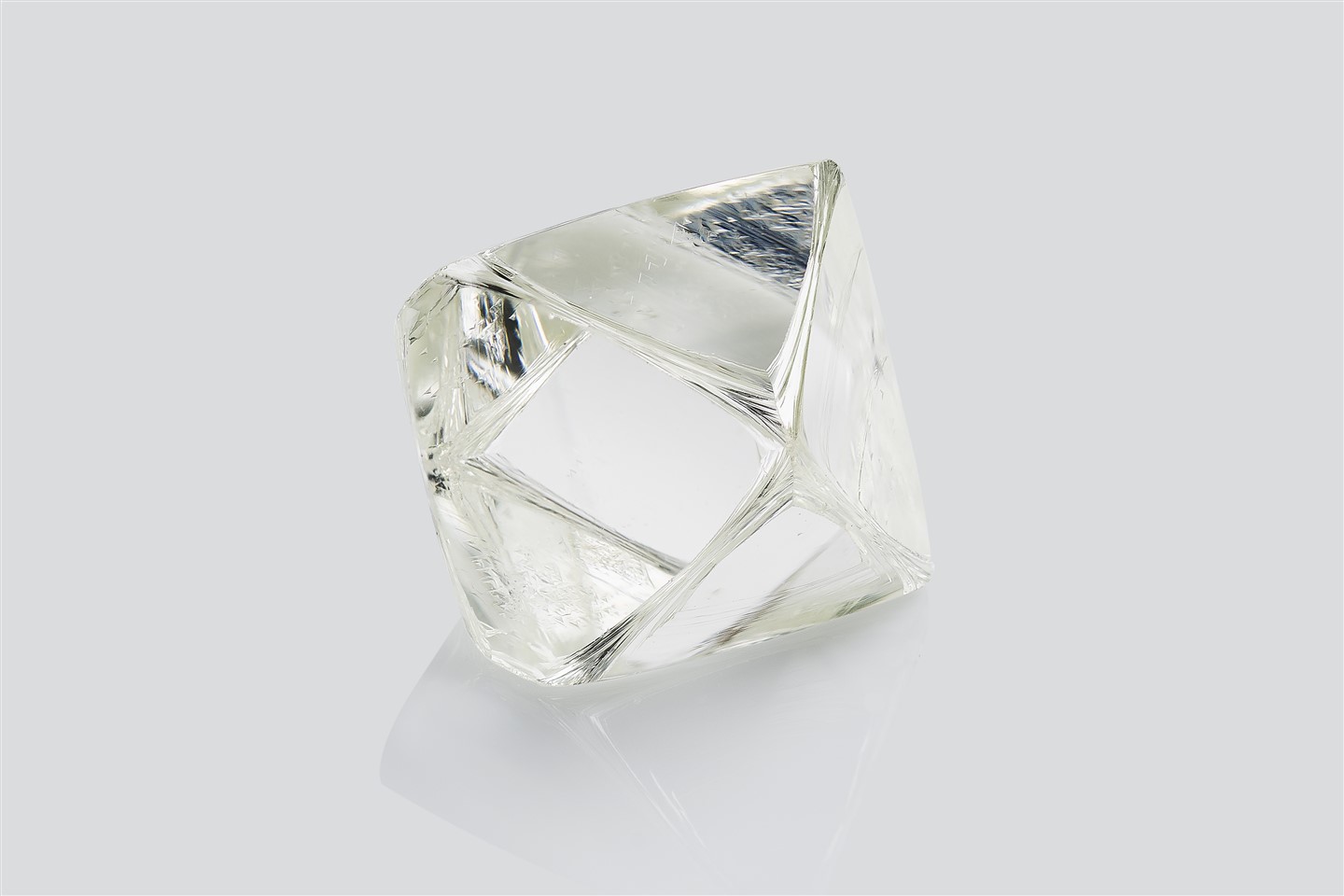
A rough princess diamond looks like two pyramids joined together. Fascinating stuff. What happens when you cut it right across the middle? Two upside-down pyramids. And what shape is a princess-cut diamond? You’ve guessed it, an upside-down pyramid.
This matters, though, because the diamond cutters end up getting much more 'yield' out of a rough diamond if they cut it into a princess-cut diamond. For example, a 1-carat rough stone like the one above might give you .40 carats of round diamonds, but the same rough might get you .50 carats of princess diamonds!
Because the square shape of a princess cut is so similar to the natural shape of the rough diamond, very little is wasted. This then translates into a lower price for you. High Five! (you must say ‘High Five’ in a Borat voice in your mind, or else it doesn’t count. Say it.)
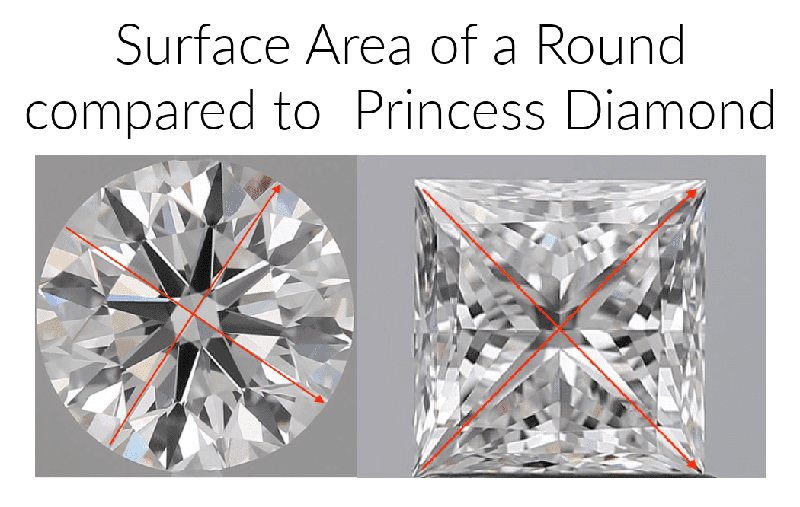
Princess-cut diamonds are not one-trick ponies, you guys! Not only will they help you save a bit of cash on your engagement ring, but the square shape can also give the illusion of being a little bigger than their round counterparts, simply because from corner to corner, a princess-cut diamond is spread just a little wider than the diameter of a round diamond shape.
One thing to bear in mind, though; once that princess diamond sits in her forever home, the prongs of the ring setting will hide a little bit of that extra junk.
Princess Diamond Cut History
The princess cut is not, in fact, made for a princess - it was actually created in London in the 1960s by a diamond cutter named Arpad Nagy (he called it a ‘profile cut’ though, because why not). Good old Arpad set out to create a fiery and brilliant alternative to the round diamond we all know and love.
Princess Cut Symmetry
Speaking of measurements, let’s talk about symmetry. Let’s put our honesty hats on for a second here and admit that princess cuts with uneven sides or unequal proportions are, how to put this... ‘unpleasant on the eye.’ If you look below, you’ll see what I mean:
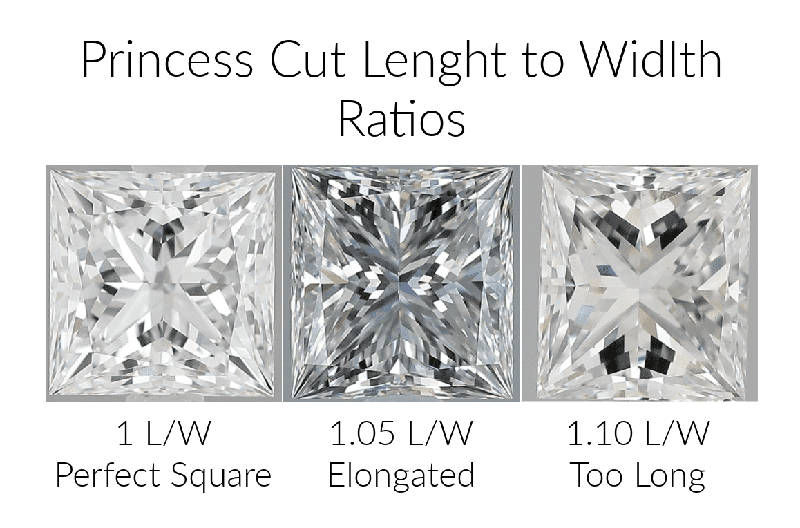
The 1:1 ratio princess cut makes me feel calm and relaxed, like I’ve just finished a super zen yoga class, and everything is right with the world. The ratio 1:1.05 ratio princess makes me feel like I’ve stood up too quickly, and my eyes are taking too long to adjust to reality…and that reality is ugly. The 1:1.10 ratio princess cut makes me feel like I’m in the Netflix show ‘Stranger Things.’ I’m basically in The Upside Down, and I don’t care for it one bit.
To avoid The Upside Down, picture yourself drawing an imaginary horizontal line across the diamond. Are the facets on the bottom and the top halves of the diamond symmetrical? Congratulations, you are not in The Upside Down.
Cut for Princess Shape
So where do princess cut diamonds stand in relation to our all-important 4Cs? Let’s take a look, beginning with the most important: cut.
If you have read my previous pieces (you should, they’re awesome), then you will know that ‘cut’ is hands down their most important characteristic. Buying a poorly cut diamond is the equivalent of buying a top-of-the-range Lamborghini and crashing it into a wall on purpose.
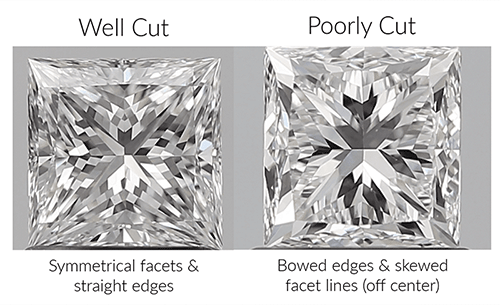
Since the GIA doesn't grade cut for any of the fancy shapes (that's everything but the round), you won't see a traditional cut grade on the report. So we look at the polish, symmetry, proportions, and overall look of the stone (that's why pictures and videos are so important here) to ensure it's cut well. We make sure the facets are properly aligned and not misshapen, the corners are sharp and not chipped, and that the outline is square and not bowed. You can use the above image to help you with your search, but seeking the advice of one of our graduate gemologists is the best help we can offer. They'll make sure you find an awesome princess-cut diamond!
Princess Cut Chevrons?
Another aspect of diamond cut to be aware of when it comes to princess shapes are chevrons. Very simply, a chevron is a type of facet or ‘step’ cut into the sides of a diamond. The number of these chevrons actually impacts the look of the diamond, so you better pay attention.
Fewer chevrons will mean that your diamond will have a chunkier feel in terms of sparkle. This is because there is more space between the facets, and therefore, the light takes longer to bounce around from one to another. More chevrons mean more facets which, of course, means that the light jumps around in that little baby at a much faster rate, making it much more sparkly (and giving the stone a sort of ‘crushed ice’ look);
The number of chevrons you want is totally up to you. You just need to be aware of how they will affect your diamond aesthetically. Here is where you can find the chevron details on the report.
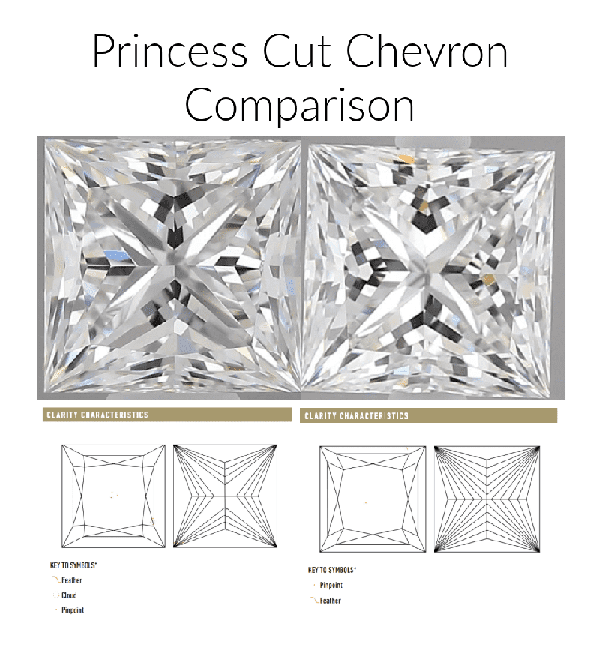
Princess Cut Color and Clarity
Finally, let’s discuss two other aspects of quality; color and clarity. In terms of color, I would go for ‘I’ color or better. If the stone is on the larger side, bump that up towards ‘H’ or even ‘G’ if you can. As with round cuts, my advice is to stay away from those ‘D-F’ colors unless you feel very strongly about them. You’re not gaining much, and your wallet will be significantly lighter for it.
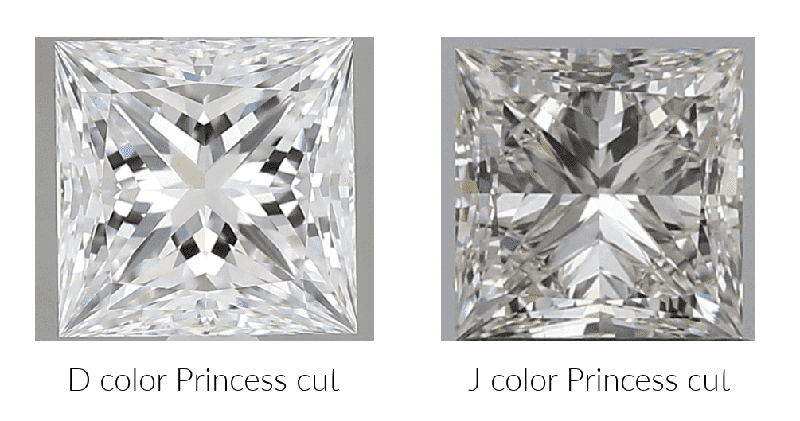
Going warmer than a ‘J’ color could be problematic, as princess cut diamonds tend to hold on to color slightly more than their round cousins. That being said, if you like a warmer tone in your diamond or plan to have a rose or yellow gold setting, I say each to their own.
Clarity-wise, princess cut engagement rings tend to be more forgiving regarding imperfections than their emerald or asscher cut cousins. You can look a touch above the SI2 mark - around the VS1 – SI1 mark for the best value. That said, you need to be acutely aware of the locations of any inclusions, especially if they sit in the corners where the princess cut is the weakest (and therefore more prone to chipping).
Study the plot of the stone extensively on the grading report, and as always (and I cannot stress this enough, ever) - look at the stone in person if possible (or at the very least with high-definition photographs from the seller.
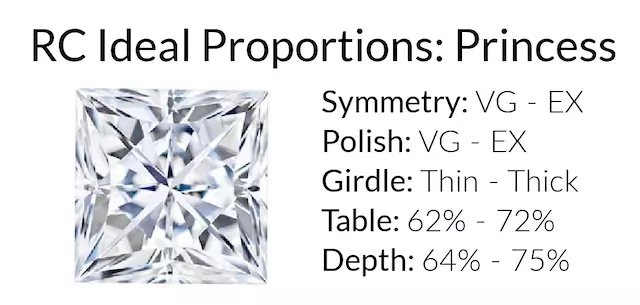
Still Not Sure the Princess Cut is Right for You?
Read more about them below!
- Guide to the Princess Cut Ring
- Diamond Cuts and Shapes: Princess Cut
- Anything For my Princess! A Guide to Princess Cut Diamonds
- What's the best cut grade for this shape? Read more here!
Read these articles for other Shapes and Cuts;
- Marquise diamond cut buying guide
- Heart diamond cut buying guide
- Cushion diamond cut buying guide
- Oval diamond cut buying guide
- Round diamond cut buying guide
- Radiant diamond cut buying guide
- Pear diamond cut buying guide
- Asscher diamond cut buying guide
- Princess diamond cut buying guide

